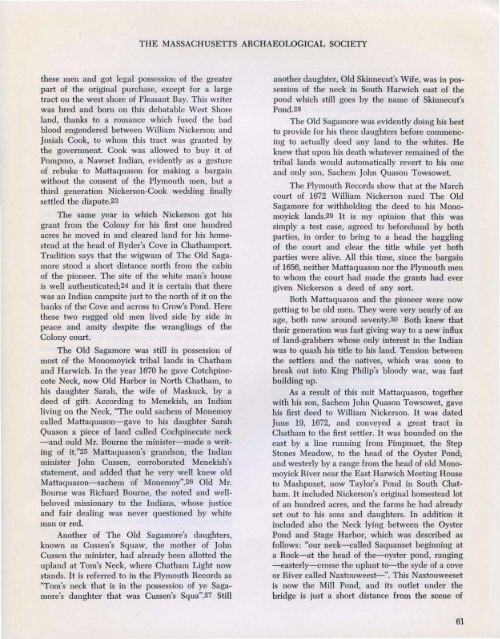Volume 19, 19(4)
Volume 19, 19(4)
Volume 19, 19(4)
Create successful ePaper yourself
Turn your PDF publications into a flip-book with our unique Google optimized e-Paper software.
these men and got legal possession of the greater<br />
part of the original purchase, except for a large<br />
tract on the west shore of Pleasant Bay. This writer<br />
was bred and born on this debatable West Shore<br />
land, thanks to a romance which fused the bad<br />
blood engendered between William Nickerson and<br />
Josiah Cook, to whom this tract was granted by<br />
the government. Cook was allowed to buy it of<br />
Pompmo, a Nawset Indian, evidently as a gesture<br />
of rebuke to Mattaquason for making a bargain<br />
without the consent of the Plymouth men, but a<br />
third generation Nickerson-Cook wedding finally<br />
settled the dispute.23<br />
The same year in which Nickerson got his<br />
grant from the Colony for his first one hundred<br />
acres he moved in and cleared land for his homestead<br />
at the head of Ryder's Cove in Chathamport.<br />
Tradition says that the wigwam of The Old Sagamore<br />
stood a short distance north from the cabin<br />
of the pioneer. The site of the white man's house<br />
is well authenticated;24 and it is certain that there<br />
was an Indian campsite just to the north of it on the<br />
banks of the Cove and across to Crow's Pond. Here<br />
these two rugged old men lived side by side in<br />
peace and amity despite the wranglings of the<br />
Colony court.<br />
The Old Sagamore was still in possession of<br />
most of the Monomoyick tribal lands in Chatham<br />
and Harwich. In the year 1670 he gave Cotchpinecote<br />
Neck, now Old Harbor in North Chatham, to<br />
his daughter Sarah, the wife of Maskuck, by a<br />
deed of gift. According to Menekish, an Indian<br />
living on the Neck, "The ould sachem of Monemoy<br />
called Mattaquason-gave to his daughter Sarah<br />
Quason a piece of land called Cochpinecate neck<br />
-and ould Mr. Bourne the minister-made a writing<br />
of it."25 Mattaquason's grandson, the Indian<br />
minister John Cussen, corroborated Menekish's<br />
statement, and added that he very well knew old<br />
Mattaquason-sachem of Monemoy".26 Old Mr.<br />
Bourne was Richard Bourne, the noted and wellbeloved<br />
missionary to the Indians, whose justice<br />
and fair dealing was never questioned by white<br />
man or red.<br />
Another of The Old Sagamore's daughters,<br />
known as Cussen's Squaw, the mother of John<br />
Cussen the minister, had already been allotted the<br />
upland at Tom's Neck, where Chatham Light now<br />
stands. It is referred to in the Plymouth Records as<br />
"Tom's neck that is in the possession of ye Sagamore's<br />
daughter that was Cussen's Squa".27 Still<br />
THE MASSACHUSETTS ARCHAEOLOGICAL SOCIETY<br />
another daughter, Old Skinnecut's Wife, was in possession<br />
of the neck in South Harwich east of the<br />
pond which still goes by the name of Skinnecut's<br />
Pond.28<br />
The Old Sagamore was evidently doing his best<br />
to provide for his three daughters before commencing<br />
to actually deed any land to the whites. He<br />
knew that upon his death whatever remained of the<br />
tribal lands would automatically revert to his one<br />
and only son, Sachem John Quason Towsowet.<br />
The Plymouth Records show that at the March<br />
court of 1672 William Nickerson sued The Old<br />
Sagamore for withholding the deed to his Monomoyick<br />
lands.29 It is my opinion that this was<br />
simply a test case, agreed to beforehand by both<br />
parties, in order to bring to a head the haggling<br />
of the court and clear the title while yet both<br />
parties were alive. All this time, since the bargain<br />
of 1656, neither Mattaquason nor the Plymouth men<br />
to whom the court had made the grants had ever<br />
given Nickerson a deed of any sort.<br />
Both Mattaquason and the pioneer were now<br />
getting to be old men. They were very nearly of an<br />
age, both now around seventy.30 Both knew that<br />
their generation was fast giving way to a new influx<br />
of land-grabbers whose only interest in the Indian<br />
was to quash his title to his land. Tension between<br />
the settlers and the natives, which was soon to<br />
break out into King Philip's bloody war, was fast<br />
building up.<br />
As a result of this suit Mattaquason, together<br />
with his son, Sachem John Quason Towsowet, gave<br />
his first deed to William Nickerson. It was dated<br />
June <strong>19</strong>, 1672, and conveyed a great tract in<br />
Chatham to the first settler. It was bounded on the<br />
east by a line running from Pimpnuet, the Step<br />
Stones Meadow, to the head of the Oyster Pond;<br />
and westerly by a range from the head of old Monomoyick<br />
River near the East Harwich Meeting House<br />
to Mashpoxet, now Taylor's Pond in South Chatham.<br />
It included Nickerson's original homestead lot<br />
of an hundred acres, and the farms he had already<br />
set out to his sons and daughters. In addition it<br />
included also the Neck lying between the Oyster<br />
Pond and Stage Harbor, which was described as<br />
follows: "our neck-called Saquanset beginning at<br />
a Rock-at the head of the-oyster pond, ranging<br />
-easterly-crosse the uplant to-the syde of a cove<br />
or River called Naxtouweest-". This Naxtouweeset<br />
is now the Mill Pond, and its outlet under the<br />
bridge is just a short distance from the scene of<br />
61

















